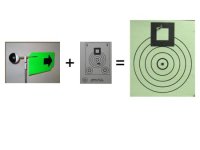Al,
Why bother with real data? Lets just see who can convince the most people without any, and then take a vote and declare the result to be reality. So little data....speaking of the wind...even numbers need to be confirmed by actual test, don't you think? I believe that the reason that this discussion has been so long is the simple lack of hard data. Yes, some things are really hard to prove. I love to speculate, but let us not confuse that, with what has been proven by actual demonstration...like in a wind tunnel. Wouldn't you think that all those aeronautical engineers would be pretty good with higher math, yet they still test. Are we better than they?
Boyd,
I can't agree re lack of hard data. I'm not disputing any work done in a wind tunnel and I'm not saying NOT to test. It's just that by definition it's "testing"..... the horse still has to push the cart!
This is old stuff, really..... it IS well understood by the engineers involved

we're (or at least I'm) just lay ignorant..... it's not our field.
The folks at Aberdeen, guys like Vaughn, McCoy, Borden and Jackson, do fully understand this stuff.... there's no confusion there. McCoy's stuff isn't speculative. It's the folks who try to understand and then teach the stuff who fail. Sierra's techs aren't professional ballisticians, they're bulletmakers who study ballistics as a hobby. This isn't a slam on them, but it doesn't invalidate the work done by folks who do it for a living. The guys at Sierra have always been great about acknowledging when they're confused. And they've come a long way.
The problem lies with US, we non-ballisticians who're striving to grasp it. It's like if I decided to design a warship or a suspension bridge..... it's not that the experts out there are confused, it's that most of us (ME anyway..

) are in a little over our heads here. Guys like me would generally have to rely on testing to destruction for the first couple bridges..... just keep driving heavier trucks over......

"oops...gotta' design a little heavier beam there....."
So once I've got a building or bridge designed I call in the numbers guys to spec it. I don't test it. The testing was done years ago.
Back when "lubricating" bullets was hailed as the Second Coming we all saw all sorts of empirical testing and many conclusions were drawn. Some folks like the late Dan Hackett used this home testing to dispute folks like Harold Vaughn. I chose to believe Harold Vaughn mainly because his credentials were better, I did NOT take the time to understand the physics. But I also believe that if Dan had presented his case with something other than "there's a lot about ballistics we don't understand" he would have gained credibility. As I try to digest "Modern Exterior Ballistics: The Launch and Flight Dynamics of Symmetric Projectiles" I don't see much that's "misunderstood."
Either McCoy's a helluva salesman or he KNOWS whereof he speaks!
A lot of engineers don't understand their stuff in depth either...... just like anywhere else some are better than others. I deal with building engineers every day (you know where I'm going with this! You've done the same thing..

) Some of them are really bright guys, some of them are just number crunchers applying formulae. The number cruncher guys often start with a bad premise and build from there.... doesn't invalidate the formulas, just the usage. GIGO
I'm not breaking any ground here, just striving to understand.
Nor am I arguing with the ballistics guys..... I'm just casually discussing with my peers. Sometimes not so casually.....


..... Ol' Vibe'rator and Toby the Tiger and Keith dished me a healthy helping of Creaux au Gratin recently because I couldn't (STILL struggling here, reading...studying) understand that a bouncy ball imparts more energy to something than a lead sap of equal mass...... I STILL have egg on my face from the muzzle brake thread..... I STILL wonder about driving pile with a rubber bumper...
but ohh well. I started off good, just got into the deeper end and floundered...
Until I can
prove differently I have to go with vibe Toby Keith and others..... My intuition was just wrong.

But I still enjoy this stuff
al









